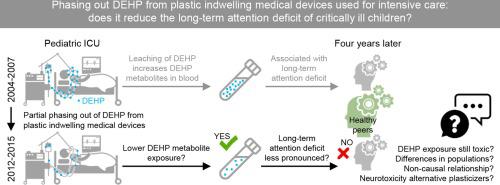Environment International ( IF 11.8 ) Pub Date : 2021-11-02 , DOI: 10.1016/j.envint.2021.106962 Ilse Vanhorebeek 1 , Govindan Malarvannan 2 , Fabian Güiza 1 , Giulia Poma 2 , Inge Derese 1 , Pieter J Wouters 1 , Koen Joosten 3 , Sascha Verbruggen 3 , Philippe G Jorens 4 , Adrian Covaci 2 , Greet Van den Berghe 1

|
Background
Children who have been critically ill face long-term developmental impairments. Iatrogenic exposure to di(2-ethylhexyl)phthalate (DEHP), a plasticizer leaching from plastic indwelling medical devices used in the pediatric intensive care unit (PICU), has been associated with the pronounced attention deficit observed in children 4 years after critical illness. As concerns about DEHP toxicity increased, governmental authorities urged the phase out of DEHP in indwelling medical devices and replacement with alternative plasticizers. We hypothesized that exposure to DEHP decreased over the years, attenuating the pronounced long-term attention deficit of these vulnerable children.
Methods
We compared plasma concentrations of 3 oxidative DEHP metabolites (5cx-MEPP, 5OH-MEHP, 5oxo-MEHP) on the last PICU day in 216 patients who participated in the Tight Glucose Control study (2004–2007) and 334 patients who participated in the PEPaNIC study (2012–2015) and survived PICU stay. Corresponding minimal exposures to these metabolites (plasma concentration multiplied with number of days in PICU) were also evaluated. In patients with 4-year follow-up data, we compared measures of attention (standardized reaction times and consistency). Comparisons were performed with univariable analyses and multivariable linear regression analyses adjusted for baseline risk factors.
Results
In the PEPaNIC patients, last PICU day plasma concentrations of 5cx-MEPP, 5OH-MEHP, 5oxo-MEHP and their sum, and corresponding minimal exposures, were reduced to 17–69% of those in the Tight Glucose Control study (p < 0.0001). Differences remained significant after multivariable adjustment (p ≤ 0.001). PEPaNIC patients did not show better attention than patients in the Tight Glucose Control study, also not after multivariable adjustment for risk factors.
Conclusion
Exposure of critically ill children to DEHP in the PICU decreased over the years, but the lower exposure did not translate into improved attention 4 years later. Whether the residual exposure may still be toxic or whether the plasticizers replacing DEHP may not be safe for neurodevelopment needs further investigation.
中文翻译:

从用于重症监护的塑料留置医疗设备中逐步淘汰 DEHP:它是否会减少重症儿童的长期注意力不足?
背景
患重病的儿童面临长期的发育障碍。医源性接触邻苯二甲酸二(2-乙基己基)酯 (DEHP) 是一种从儿科重症监护病房 (PICU) 中使用的塑料留置式医疗器械中渗出的增塑剂,与危重病 4 年后观察到的儿童明显的注意力缺陷有关。随着对 DEHP 毒性的担忧加剧,政府当局敦促在内置医疗设备中逐步淘汰 DEHP,并用替代增塑剂替代。我们假设多年来接触 DEHP 的情况有所减少,从而减轻了这些弱势儿童明显的长期注意力缺陷。
方法
我们比较了参加严格血糖控制研究(2004-2007)的 216 名患者和参加严格血糖控制研究的 334 名患者在 PICU 的最后一天的 3 种氧化 DEHP 代谢物(5cx-MEPP、5OH-MEHP、5oxo-MEHP)的血浆浓度。 PEPaNIC 研究(2012-2015 年)并在 PICU 住院期间幸存下来。还评估了对这些代谢物的相应最小暴露(血浆浓度乘以在 PICU 中的天数)。在有 4 年随访数据的患者中,我们比较了注意力测量(标准化反应时间和一致性)。采用单变量分析和针对基线风险因素调整的多变量线性回归分析进行比较。
结果
在 PEPaNIC 患者中,5cx-MEPP、5OH-MEHP、5oxo-MEHP 及其总和以及相应的最小暴露量的最后 PICU 日血浆浓度降低至严格血糖控制研究中的 17-69%(p < 0.0001 )。多变量调整后差异仍然显着(p ≤ 0.001)。PEPaNIC 患者没有表现出比严格血糖控制研究中的患者更好的注意力,在对危险因素进行多变量调整后也没有。
结论
PICU 中危重儿童接触 DEHP 的情况逐年减少,但 4 年后,较低的接触量并未转化为注意力的改善。残留的暴露是否仍然有毒,或者替代 DEHP 的增塑剂是否对神经发育不安全,需要进一步调查。


























 京公网安备 11010802027423号
京公网安备 11010802027423号